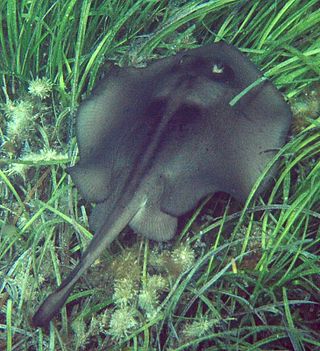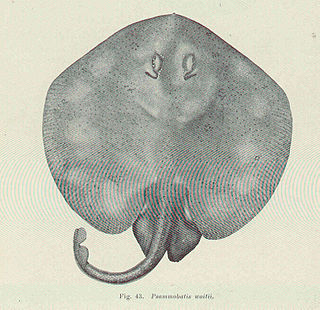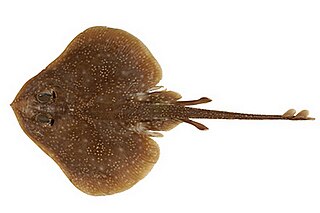
Cyprinidae is a family of freshwater fish commonly called the carp or minnow family, including the carps, the true minnows, and their relatives the barbs and barbels, among others. Cyprinidae is the largest and most diverse fish family, and the largest vertebrate animal family overall, with about 3,000 species; only 1,270 of these remain extant, divided into about 200 valid genera. Cyprinids range from about 12 mm (0.5 in) in size to the 3 m (9.8 ft) giant barb. By genus and species count, the family makes up more than two-thirds of the ostariophysian order Cypriniformes. The family name is derived from the Greek word kyprînos.

Eleotridae is a family of fish commonly known as sleeper gobies, with about 34 genera and 180 species. Most species are found in the tropical Indo-Pacific region, but there are also species in subtropical and temperate regions, warmer parts of the Americas and near the Atlantic coast in Africa. While many eleotrids pass through a planktonic stage in the sea and some spend their entire lives in the sea; as adults, the majority live in freshwater streams and brackish water. One of its genera, Caecieleotris, is troglobitic. They are especially important as predators in the freshwater stream ecosystems on oceanic islands such as New Zealand and Hawaii that otherwise lack the predatory fish families typical of nearby continents, such as catfish. Anatomically, they are similar to the gobies (Gobiidae), though unlike the majority of gobies, they do not have a pelvic sucker.
Anacanthobatis is a genus of smooth skates native to the western Indian Ocean, where found deeper than 200 m (660 ft).

Bathyraja is a large genus of skates in the family Arhynchobatidae.

Dipturus is a large genus of skates native to the Pacific, Atlantic, and Indian Oceans. They were formerly included in Raja. Some species initially moved to Dipturus were later placed in Dentiraja, Spiniraja, and Zearaja.

Notoraja is a genus of skates in the family Arhynchobatidae. They are found in deep water in the Indian and western Pacific Oceans.

Raja, also known as raia, is a genus of skates in the family Rajidae containing 16 species. Formerly a wastebasket genus, many species historically categorized here have been moved to other genera in the family, such as Amblyraja, Beringraja, Dipturus, Leucoraja and Rostroraja. Raja are flat-bodied, cartilaginous fish with a rhombic shapes due to their large pectoral fins extending from or near from the snouts to the bases of their tails. Their sharp snouts are produced by a cranial projection of rostral cartilage. The mouth and gills are located on the underside of the body. They may be either solid-coloured or patterned, and most skates have spiny or thorn-like structures on the upper surface, while some species contain weak electrical organs within their tails. Mating typically occurs in the spring and the female lays numerous eggs per clutch which are encapsulated in leathery cases, commonly known as "mermaid’s purses". Species vary in size, ranging from about 40 to 140 cm (1.3–4.6 ft) in length. These bottom-dwellers are active during both day and night, and typically feed on molluscs, crustaceans and fish. Raja skates are found in the East Atlantic, also in the Mediterranean, and western Indian Ocean, ranging from relatively shallow water to a depth of 800 m (2,600 ft). Skates and related species have fossil records dating from the Upper Cretaceous period, thus this well-adapted species is quite ancient.

Trygonoptera is a genus of round rays endemic to the waters around Australia. Müller and Henle defined Trygonoptera in 1841. It has often been considered synonymous with Urolophus, but this has been refuted by recent studies. Trygonoptera can be distinguished from Urolophus in that the outer rims of its nostrils are enlarged into broad, flattened lobes; the two also differ in aspects of the skeleton.

Urolophus is a genus of round rays mostly native to the western Pacific Ocean and the Indian Ocean, though one species occurs in the Pacific waters of the Mexican coast. Müller and Henle erected Urolophus in an 1837 issue of Bericht Akademie der Wissenschaften zu Berlin. The name is derived from the Greek oura, meaning "tail", and lophos, meaning "crest". In Urolophus, the outer rims of the nostrils are not enlarged into lobes, but may form a small knob at the back.

Irolita is a genus of softnose skates in the family Arhynchobatidae, commonly known as round skates. There are two species, both endemic to Australia, found over soft bottoms on the outer continental shelves and upper continental slopes, at depths of 50–200 m for the southern round skate and 142–209 m for the western round skate. The distributions of the two species do not overlap.
Pavoraja alleni, or Allen's skate, is a species of fish in the family Arhynchobatidae. It is bathydemersal and lives on soft bottoms of the continental shelf in depths from 304 to 458 metres. It is native to Australia. Its maximum length is 35 centimetres (14 in). It lays egg capsules which have horn-like protections in each corner. As typical of rays, it does not guard its eggs.

Pavoraja nitida, commonly known as the peacock skate, is a species of fish in the family Arhynchobatidae. It lives near the soft bottoms of the continental shelf near the coasts of southeastern Australia in depths ranging from 30 to 390 metres. It produces oblong egg capsules which have stiff horns in each corner and lays them in sandy or muddy flats. Its maximum size is 36.8 cm.
Pavoraja mosaica, commonly known as the mosaic skate, is a species of fish in the family Arhynchobatidae. It lives in depths ranging from 300 meters to 450 meters off the northeastern coast of Australia. It can reach up to 27.9 cm (11.0 in) in total length.
Pavoraja arenaria, commonly known as the sandy skate or yellow skate, is a species of fish in the family Arhynchobatidae. It lives in depths ranging from 192 to 712 meters but is usually found at 300 to 400 meters depth off the coast of western Australia. Its maximum size is 34.3 cm (13.5 in) total length. It is a little-known species that could be threatened by being taken as by-catch in trawl fisheries.
Pavoraja pseudonitida, commonly known as the false peacock skate, is a species of fish in the family Arhynchobatidae. It lives in depths ranging from 212 to 512 meters in the western Pacific Ocean off the coast of north-eastern Australia. Its maximum size is 37.2 cm (14.6 in) total length.
Pavoraja umbrosa, commonly known as the dusky skate, is a species of fish in the family Arhynchobatidae. It lives off the coast of north-eastern Australia in depths ranging from 360 to 731 meters. Its maximum size is 36.9 cm (14.5 in) total length.

Pristiophorus is a genus of sawsharks found in the Pacific, Atlantic and Indian oceans. Members of this genus differ from the Sixgill Sawshark (Pliotrema warreni) in having five gill slits. Their rostral sawteeth lack prominent transverse ridges on the basal ledges, and the large teeth are not posteriorly serrated.
Brochiraja is a genus of deep-sea skates in the family Arhynchobatidae containing eight species. They are found in the waters around New Zealand and the Tasman Sea.
Insentiraja is a genus of skates in the family Arhynchobatidae commonly known as looseskin skates. The genus contains two known species, both of which occur in deep water in the western-central Pacific Ocean.

Zearaja is a small genus of skates in the family Rajidae. It currently consists of four described species found in oceans off New Zealand, Tasmania and southern South America.












